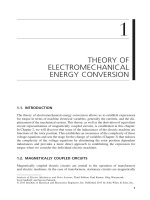Print SV chapter 1 overview of negotiation
Bạn đang xem bản rút gọn của tài liệu. Xem và tải ngay bản đầy đủ của tài liệu tại đây (1.27 MB, 43 trang )
BUSINESS NEGOTIATION
Mr. CHÂU THẾ HỮU – MBA
International Business Administration Department
0907 414 021
CHAPTER 1
OVERVIEW OF NEGOTIATION
In this chapter
1.
Overview on Negotiation
2.
Types of negotiation
3.
Principled negotiation
1. Overview of Negotiation
Definitions
Features
Negotiation in international business
1.1. Definitions
Negotiate (v) to try to reach an agreement by formal discussion
(Oxford Advanced Learners)
Negotiation is a basic means of getting what you want from others. It is
back-and-forth communication designed to reach an agreement when you and
the other side have some interests that are shared and others that are
opposed.
(Roger Fisher & William Ury)
Prerequisites of negotiation
A conversation is considered as “negotiation” when there are:
Interdependence between parties
Beneficial conflicts
Power equivalence
Target which is agreement
1.2. Features
Maximize Common benefits and minimize conflicting private ones.
Negotiation aims at Agreement, not Winning position.
Negotiation is affected by status and power of both parties.
Negotiation: an art and science!!!
1.3. Negotiation in international business
Definition: Negotiation relating to business transactions between parties with
different nationalities.
International business negotiation is affected by:
Economics laws
Politic and democratic relations
Fluctuation in the world market and economy
Legal framework
Cultures
2. Types of negotiation
Based on forms
Based on strategy
2.1. Forms of Negotiation
Face-to-face
Negotiation via phone
Negotiation via mails / faxes
Negotiation via e-commerce applications (emails, social media...)
Advantages and Disadvantages
2.2. From a strategic view
Strategy vs Tactics?
Negotiation strategies
Competitive strategy / Win-Lose
Cooperative strategy / Win-Win
Lose - Lose
Compromising strategy
Positioning strategy: Hard vs Soft
Principled strategy
3. Principled Negotiation
The problem
The method
Commonly asked questions
3.1. The problem
Arguing over positions…
Produces unwise agreements
Is inefficient
Endangers an ongoing relationship
Other cases
When there are many parties? even worse
Being nice? no answer
3.2. The method
Separate the People from the Problem
Focus on Interests, not Positions
Invent Options for Mutual Gain
Insist on Using Objective Criteria
3.2.1 Separate the People from the Problem
Negotiators are people first.
Every negotiator has 2 kinds of interests: In the substance and in the
relationship.
Separate the relationship from the substance; deal directly with the people
problem.
Prevention works best.
Separate the RELATIONSHIP from the substance; deal
directly with the PEOPLE problem.
Perception
Put yourself in their shoes.
Don’t deduce their intentions from your fears.
Don’t blame them for your problem.
Discuss each other’s perceptions.
Look for opportunities to act inconsistently with their perceptions.
Give them a stake in the outcome by making sure they participate in the process
Face-saving: Make your proposal consistent with their values.
Separate the RELATIONSHIP from the substance; deal
directly with the PEOPLE problem.
Emotion
Recognize and understand emotions, theirs and yours.
Make emotions explicit and acknowledge them as legitimate.
Allow the other side to let off steam.
Don’t react to emotional outbursts.
Use symbolic gestures.
Separate the RELATIONSHIP from the substance; deal
directly with the PEOPLE problem.
Communication
- Problems:
Negotiators may not be talking to each other.
They may not be hearing you.
Misunderstanding
- Solutions:
Listen actively and acknowledge what is being said.
Speak to be understood.
Speak about yourself, not about them.
Speak for a purpose.
Prevention works best
Build a working relationship
Face the problem, not the people
Let me say this as clearly as I can: the United States is not at war with
Islam and will never be.
3.2.2. Focus on INTERESTS, not Positions
For a wise solution reconcile interests, not positions
How to identify interests?
Talking about interests
For a wise solution reconcile interests, not positions
Interests define the problem
Behind opposed positions lie shared and compatible interests, as well as
conflicting ones.









